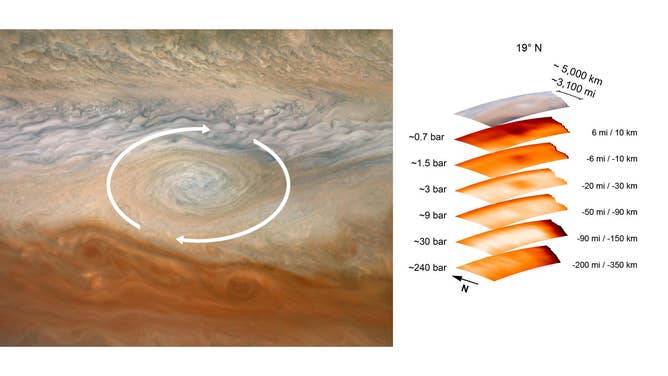Storms on Jupiter go deep below its turbulent cloud tops, new studies shows
Jupiter's Great Red Spot extends hundreds of miles below the clouds.

The three-dimensional character of Jupiter's cloud decks is captured in this image of the planet's North Equatorial Belt. Orange storms peek out from under banks of dark gray clouds. Lighter tan and gray clouds cast narrow shadows on the dark gray cloud bank below. Image data: NASA/JPL-Caltech/SwRI/MSSSImage processing: Brian Swift
(NASA JPL)
What goes on below Jupiter's atmosphere is a bit of a mystery, but researchers are closer to understanding how it works with observations from NASA's Juno spacecraft.
NASA's space probe has been orbiting the gas giant since 2016 and has completed 37 passes so far using its suite of science instruments to view beneath the swirling and stormy clouds. Part of what makes Jupiter so fascinating is the weather unfolding at the atmospheric level.
Several papers were recently published in the Journal of Geophysical Research: Planets and Geophysical Research Letters based on NASA's Juno spacecraft observations. Using Juno data, the researchers could peer down beneath the swirling surface and estimate just how deep some of these storms go.
According to a new study, the angry swirling Great Red Spot is more significant than Earth and caused by a giant storm that researchers now believe goes down 300 miles below the cloud tops of Jupiter.
Using Juno’s microwave radiometer (MWR), scientists looked beneath Jupiter’s cloud tops to better understand its numerous vortex storms, including the Great Red Spot. Researchers have found that the cyclones that rotate are warming on top with lower atmospheric densities and are colder at the bottom with higher densities. Whereas the anticyclones, turning in the opposite direction, are colder at the top and warmer below.

The annotated image on the left from the JunoCam imager aboard NASA's Juno spacecraft depicts the counterclockwise rotation of Jupiter's Great Red Spot. The graphic on the right highlights the large-scale structure of the Great Red Spot as seen by the spacecraft's microwave radiometer (MWR) instrument.
(NASA/JPL-Caltech/SwRI/MSSSImage processing: Kevin Gill )
According to NASA, this shows "the vortices cover regions beyond those where water condenses and clouds form, below the depth where sunlight warms the atmosphere."
Marzia Parisi, a Juno scientist from NASA's Jet Propulsion Laboratory in Southern California and lead author of a paper in the Journal Science, said a 2019 June spacecraft flyby helped make this discovery, requiring extreme precision.
"Being able to complement MWR's finding on the depth gives us great confidence that future gravity experiments at Jupiter will yield equally intriguing results," Parisi said.
Researchers behind another study using Juno observations say they have solved a "long-standing puzzle" regarding the unseen flow of Jupiter's sub-clouds. Using measurements of the Jovian atmosphere, researchers found evidence that there are eight deep circulation cells in each hemisphere of the planet. In contrast, on Earth, there is only one such cell in each hemisphere.
According to NASA, researchers have been trying to understand how Jupiter's jet streams researching depths of 2,000 miles form. They now believe the atmosphere's ammonia gas travels up and down these jet streams.

The image on the left, taken by the JunoCam imager aboard NASA's Juno spacecraft, has been annotated to depict the clockwise rotation of a vortex at Jupiter. The graphic on the right highlights the large-scale structure of the feature as seen by the spacecraft's microwave radiometer (MWR) instrument. Image data: NASA/JPL-Caltech/SwRI/MSSSImage processing: Björn Jóhnsson CC BY
(NASA JPL)
"By following the ammonia, we found circulation cells in both the north and south hemispheres that are similar in nature to 'Ferrel cells,' which control much of our climate here on Earth," said Keren Duer of the Weizmann Institute of Science in Israel and the study's lead author. "While Earth has one Ferrel cell per hemisphere, Jupiter has eight – each at least 30 times larger."
According to the National Oceanic and Atmospheric Administration, Earth has three global circulation cells, including the Ferrel cell.
"The Ferrel cell is a mid-latitude global circulation, this circulation is where we get our westerly winds from," FOX Weather meteorologist Marissa Lautenbacher said. "The northern portion of the Ferrel cell has our polar jet stream which drives our storm systems across the U.S."
According to the study, on Jupiter, these circulation cells gain energy from atmospheric waves and extend down hundreds of kilometers.
Jupiter can contain more circulation cells because it's 11 times more expansive and is the fastest spinning planet in the solar system. While Earth rotates once every 24 hours, Jupiter takes less than 10 hours.
NASA has extended funding for the Juno mission through 2022 to allow for more science observations. It takes 53 days for Juno to orbit the giant planet.